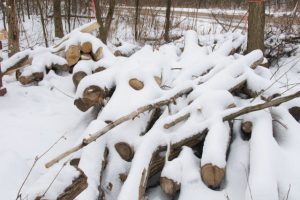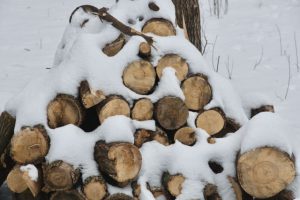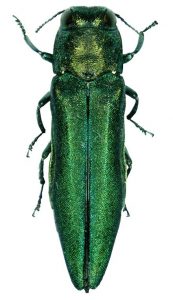emerald ash borer
Agrilus planipennis

The Problem
Emerald Ash Borer is an invasive beetle that attacks all native species of ash trees; including green, white, black, blue and pumpkin. The EAB lays its eggs in crevices of the bark. When the eggs hatch they borer through the bark. Larvae spend the next 12-18 months eating the sapwood layer of the ash trees, which includes the phloem, cambium and xylem layers. As they feed on these layers, larvae leave tunnels in their wake. These tunnels do not grow closed. Sap continues the flow through remaining phloem tissues, but the tree becomes increasing weak as its supply of water and nutrients decreases. After several years of infestation by successive generations of the EAB, enough tunnels are created that sap flow stops and the tree dies.
Quarantine measures in Wisconsin were effective at reducing spread of emerald ash borer in nursery stock and commercial forestry lands. EAB still made its way to many parts of the state in firewood or simply because adult beetles can fly up to 35 miles in a season.

The mortality rate for infested stands appears to be between 95-99%, with many stands losing every mature tree. This process takes several years, during which the crown becomes increasingly sparse and limbs being to fall off. Woodpeckers eat the larvae. As they peck to get off the larvae, the birds rip small chunks of bark from the tree. As this process continues large patches of bark are removed causing large sections of the trunk to appear blond.

Faint Hope
Less than 1% of ash trees in most stands survive EAB infestation. While nurseries are taking cuttings from ash trees that appear to be resistant, bringing restraint strains to market could take 10-15 years. An imported species called Manchurian ash is beginning to be introduced for use in urban settings.
Several beetles are being investigated as biological controls for emerald ash borer. Even if they are successful, they would not eliminate the pest. At best, they might reduce EAB numbers, reducing the number of trees that actually die from infestations.

Logs
Recently, the USDA lifted the federal quarantine from EAB impacted states. Most importantly, it removed federal restrictions on shipping logs across state boundaries. States, however, can still restrict shipments. Minnesota still has state quarantine restrictions in place. Until WI and MN reach an agreement, logs from Minnesota will still require inspection and regulation prior to crossing state lines.
Since Wisconsin processes most logs inside the state, landowners should still be able to find markets for their timber. International trade with China dried up when trade talks broke down, so that market is not likely to return any time soon.

Firewood
The DNR and Department of Agriculture continue to discourage moving firewood. People hauling firewood also spread other pests like gypsy moth, Dutch elm disease and oak wilt into uninfected areas.
Firewood brought into state parks must be from local suppliers within 25 miles of the park. This restriction remains in effect regardless of changes to the quarantine rules.

Taking Action
So, what do you do when you see a dying tree on your hunting land or near your cabin? If caught early, treat trees with injectable insecticide specifically designed to kill EAB larvae. Chemical injection costs too much for timber stands. It is a viable choice for specimen yard and street terrace trees. The UW Extension has a Homeowner Guide to Emerald Ash Borer Insecticide Treatments that provides guidance for those who want to fight back against this tough invader.
Pests spread when firewood is still alive or just recently dead. EAB larvae move on once a tree is totally dead for several years and the bark is already falling off. Let your trees cure in the woods for a few years before harvesting them for firewood.
Don’t want to wait that long? You can debark the tree and leave it out for the winter to kill any remaining insects or pathogens. I use a draw knife (keep it sharp) along with a pry bar and hammer. Some species peal easily when green, while others resist until logs have a while dry.
Additional information:
- Feds throw in the towel on emerald ash borer
- Homeowners’ Guide to Emerald Ash Borer Treatments
- USDA – Questions and Answers: Biological Control for Emerald Ash Borer
- Wisconsin DATCP – Emerald Ash Borer
Return to Animals
